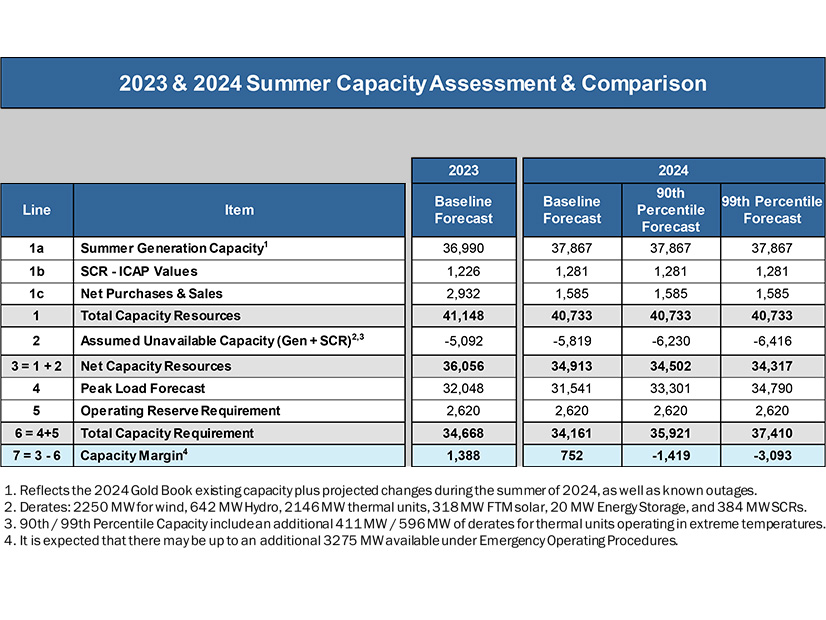NYISO stakeholders on May 29 scolded the ISO for using the wrong figure in a press release on its summer capacity assessment, saying it suggested capacity margins would be tighter this summer than expected.
Aaron Markham, NYISO vice president of operations, was presenting the ISO’s assessment, which had been presented to the Operating Committee on May 16, to the Management Committee. (See NYISO Reports Adequate Capacity for Summer, but Heat Waves a Concern.) The ISO said there is enough capacity to serve peak load this summer under its baseline forecast, but it made a point of noting that margins continue to shrink and that a prolonged heat wave could lead to emergency operations.
NYISO expects to have about 40.7 GW of total capacity (34.9 GW after expected derates) to serve an expected peak load of about 31.5 GW. The day after the presentation to the OC, however, the ISO issued a press release reporting a “forecasted peak demand conditions of 33,301 MW.”
That figure is actually the ISO’s predicted peak load under its 90/10 forecast, an extreme weather scenario it expects has only a 10% chance of happening.
“I think it was a bit misleading to do that, as opposed to describing our baseline forecast and the conditions that you would expect,” said Howard Fromer of PSEG Power. “It kind of suggested that things are much worse than our market is intended to support. … If we think 90/10 is our reality, we need to have a conversation about how we’re setting our markets.”
He noted that the sentence following the figure reads, “In 2023, summer peak demand reached 30,206 MW.”
“It suggests that there’s a year-over-year increase of over 3,000 MW in spite of everything New York state is doing,” such as energy efficiency and behind-the-meter solar, Fromer said.
The Times Union reported the 90/10 figure as the expected peak load and quoted Gavin Donohue, president of the Independent Power Producers of New York, as saying, “This has been a concern for quite some time, and now it is a red light concern.” T&D World’s report on the assessment was headlined “NYISO Warns of Potential Summer Power Shortages Despite Adequate Supplies Under Normal Conditions,” also reporting the 90/10 figure.
“I very much support the concern about NYISO’s press release,” said Christopher Casey, utility regulatory director for the Natural Resources Defense Council. “I’ve been raising my own concerns with NYISO’s press releases for almost a year now, and I think NYISO is increasingly giving a confusing message to the public. Having the release focused on the 90/10 criteria … is pretty misleading.”
Marc Montalvo of Daymark Energy Advisors said NERC’s 2024 Summer Reliability Assessment, released May 15, found “the New York region being essentially normal, sufficient; no expectations for issues or insufficient operating reserves,” while CAISO, ERCOT, MISO and ISO-NE face an “elevated” risk of insufficient operating reserves in above-normal conditions. (See NERC Summer Assessment Sees Some Risk in Extreme Heat Waves.)
“But this [NYISO’s assessment] looks like, under high-load conditions, that you might have an expectation of operating reserve shortages. So I’m trying to reconcile these two presentations,” Montalvo said. “If there’s one set of information that suggests a certain type of [condition or concern], and ostensibly measuring the same thing, and it looks like it’s telling a different story, it can be a bit confusing.”
“We provide the NERC assessment with data in the format that they want it,” Markham said. “Here we try to take a little bit more conservative view of what conditions might look like in New York. … There can be various ways of accounting for forced outages of generation and how you calculate that number. … Here we use the average over five years.”
‘Contributing to the Problem’
While NERC did say NYISO is expected to have sufficient reserves, it noted that a probabilistic assessment by the Northeast Power Coordinating Council found the ISO “could experience resource shortages during high-demand conditions and require limited use of operating procedures for mitigation.” However, even under the highest peak load scenarios, NPCC estimated a “small” cumulative loss-of-load expectation of 1.6 days for the season.
Casey expressed confusion about “why [NYISO is] deciding that [data] should be presented and discussed differently to a stakeholder and New York public audience versus when you’re reporting to” FERC and NERC.
“I think the ISO is in some respects … contributing to the problem here,” said Mark Younger, president of Hudson Energy Economics. “The summer assessment is not an evaluation of whether the ISO is likely to be unable to meet its loads. The summer assessment is an evaluation of whether the ISO can operate its system and remain under normal operating parameters for the whole thing. That is a long distance from where we are at risk of failing to meet load. … The ability to use [emergency operating procedures] is probably something the general public and reporters would not at all understand.”
Robert Fernandez, NYISO general counsel and chief compliance officer, said he appreciated the feedback, but “I reject categorically any implication that there was an intention to mislead the public or anyone else here. That is simply not the case. … We can talk about clarifying [the presentation], but … you guys know us better than that.”
“I don’t think you intended to, Rob; I’m not suggesting that at all,” Fromer replied. “But the casual reader is going to look at this press release and say, ‘Wow, our load went up 3,000 MW from last summer!’”



